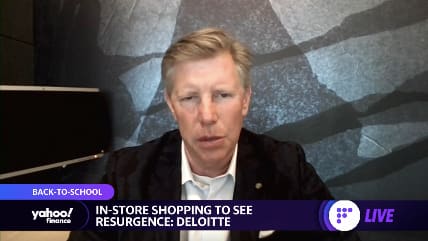Rod Sides, Deloitte Global Insights leader, joins Yahoo Finance Live to break down findings from the company’s back-to-school retail report.
Video Transcript
SEANA SMITH: All right, well, it is that time of year again. Families are hitting the stores, hunting for the best bargains on backpacks, notebooks, their child’s favorite cartoon character on a lunchbox. Well, in a new report out from Deloitte, inflation is driving this year’s spending up another 8%.
Let’s unpack this with Rod Sides. He’s the global leader of Deloitte Insights. It’s great to see you. When I look at this survey, my big question is, obviously, we’re in the face of higher inflation. It still seems, though, like parents are willing to spend. What was your big takeaway from this survey?
ROD SIDES: Yeah, absolutely. What we found is that parents are looking to make sure they make the back to school season really work for them. They’re dipping into savings. Savings rates actually down a little bit as we go. People are looking at things like buy now, pay later. And so they’re really are trying to step up on behalf of the kids, as they go into this back to school season. So, again, we’re seeing about an 8% growth in K-12 and about 10% in college. So parents are stretching beyond their means in a lot of cases.
DAVE BRIGGS: And those numbers, when you break down per K through 12 student, is more than $600 per student, which is some eye-popping numbers. How do you break down that number? And what’s the biggest chunk of that spending?
ROD SIDES: Well, what’s really interesting is apparel plays a big role and then tech also. But we saw tech, as a category, start to cool. What we found in the last two years was tech spending was way up, as folks were trying to get their kids educated from home. Now what we’re seeing is a pretty big decline there, but those are big ticket items, so that does make up a big part of that.
Apparel looks like it’s going to be the big winner. What we found is a lot of folks are looking to make sure the kids have the new clothes, et cetera, because they’re not going to be on camera as much. And I think there’s a little catch-up there in terms of that particular category. So it’s interesting to see that move this year specifically.
RACHELLE AKUFFO: And what are the strongest categories you’re seeing amongst college age students?
ROD SIDES: Well, tech is just the opposite. So in that case, tech is the number one category. We’re continuing to see that to grow fairly dramatically. And it makes sense, as kids move in to college. A lot of the K-12 has been, provide the device. And I think there’s a lot of reason why they did that. It’s kind of a “bring your own” environment as kids go to college. And so as a result, we’ve seen tech continue to grow there. And I think there’s a number of stores. The tech stores are going to do quite well with that particular category.
SEANA SMITH: Hey, Rod, what about certain stores, certain brands? We talk about Gen Z really being attracted to those companies that place an emphasis on sustainability, on the environment. Is that the case with some of these parents who are buying the items for their kids?
ROD SIDES: Yeah, that was one of the biggest surprises this year, is we actually saw parents’ desire for sustainable products really grow and about 50% in both the back to school and the back to college categories. So that was going to be important to them. But what was really interesting is that for those parents, on average, they spend about 22% more in the back to school. So they’re willing to pay more for sustainable products.
DAVE BRIGGS: One number that really stood out to me was that parents planned to spend 49% of their budget in store this year, up from 43% a year ago. Is that a reflection of a return to brick and mortar, or rather, just distance from the pandemic?
ROD SIDES: I think it’s a return to brick and mortar, to a certain degree. If you go back and look at where we were in ’17 and ’18, back to school was largely an in-store type of experience. About 57% back then were in-store versus online.
Now, what we found is, coming out of the pandemic, the convenience of having your kids try on those shoes and clothes, et cetera, really makes the store the right answer for a lot of parents. Now, we also know that digital is going to continue to grow, so it’s not going away. But I think we are getting back to some level of normalcy as we go into this season.
RACHELLE AKUFFO: And which retailers, do you think, are really reaping the biggest benefits of this right now?
ROD SIDES: Wow, that’s a great question. I think what we normally see, masks do really well. They generally lead in almost every category. And I think they’ll do fine. About 81% of respondents said that they would shop the masks category.
Online only, we saw go up fairly dramatically as well. But what’s really interesting this year with apparel is we’re seeing returns to department stores and specialty clothing. So both are back to the point where they were about four years ago in terms of number of folks who are going to shop those venues. So I think the department stores are going to have a nice rebound, if you will, coming off the pandemic.
SEANA SMITH: Rod, what about the supply chain issues? Is that affecting when people are ordering? Because we certainly saw it play out last year on the back to school time and, certainly, over the holidays. Has that kind of brought some of the back to school spending forward?
ROD SIDES: Well, what’s really interesting is that when we asked the question, about 63% said they were really worried about the stock out type issue. However, when we looked at when they’re planning to shop, we’re back to the same curves that we were pre-pandemic, and, certainly, from where we were last year.
So the peak period will be the next two weeks, the last two weeks of July. And then it’ll trail off the first two weeks of August, et cetera. But the curve looks almost exactly the way it did before we got into the pandemic. So parents are saying one thing around worrying about stock-outs, but at the end of the day, it looks like they’re going to shop at the same time.
RACHELLE AKUFFO: And Rod, obviously, it’s been an incredibly tough few years for students of all ages– for everyone, really, but specifically, for students. What are you seeing in terms of, perhaps, spending when it comes to things to support mental health, as the kids return back to school?
ROD SIDES: Well, thanks for asking that. That was one of the first questions we asked this year, because we just know how stressful it’s been on families over the last two years. And so, what we know is about 50% of the parents, both in the back to school and the back to college, said they’re worried about their kids’ mental wellness, et cetera. And 36% have already spent on products to help with that.
So whether that be online meditation, whether it be extracurricular activities, yoga classes, et cetera, we know that parents are investing. But the interesting thing about it is that investment will last all year. So I think there’s an opportunity for retailers to message that, that they understand that well-being and mental health is really important throughout the balance of the school year. And there’s opportunities to address that, for sure.
DAVE BRIGGS: Indeed, an important point and a trend we certainly see coming out of COVID. Rod Sides from Deloitte, thanks so much.






